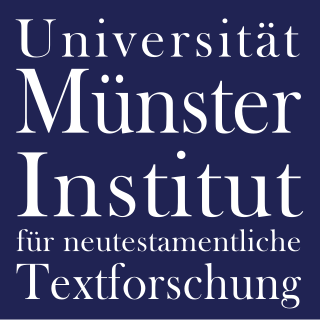History
Gregory dated the manuscript to the 10th century. [3] It has been assigned by the Institute for New Testament Textual Research to the 10th century. [1] [2]

The Institute for New Testament Textual Research at the University of Münster, Westphalia, Germany, is to research the textual history of the New Testament and to reconstruct its Greek initial text on the basis of the entire manuscript tradition, the early translations and patristic citations; furthermore the preparation of an Editio Critica Maior based on the entire tradition of the New Testament in Greek manuscripts, early versions and New Testament quotations in ancient Christian literature. Under Kurt Aland's supervision, the INTF collected almost the entire material that was needed - Manuscript count 1950: 4250; 1983: 5460; 2017: approx. 5800.
Anselmo Banduri presented the manuscript to Bernard de Montfaucon. The manuscript was known to Johann Jakob Wettstein, Johann Jakob Griesbach and Johann Martin Augustin Scholz. [3]
Anselmo Banduri was a Benedictine scholar, archaeologist and numismatologist from the Republic of Ragusa.

Dom Bernard de Montfaucon, O.S.B. was a French Benedictine monk of the Congregation of Saint Maur. He was an astute scholar who founded the discipline of palaeography, as well as being an editor of works of the Fathers of the Church. He is regarded as one of the founders of the modern discipline of archaeology.
Johann Jakob Wettstein was a Protestant Swiss theologian, best known as a New Testament critic.
The manuscript was added to the list of New Testament manuscripts by Wettstein (suglum Oe). Gregory gave to it the number 295e. [3]

Caspar René Gregory was an American-born German theologian.
The manuscript is not cited in the critical editions of the Greek New Testament (UBS3). [4]
The owner of the codex is unknown. [1] [2]
Minuscule 110, α 204 (Soden), is a Greek minuscule manuscript of the New Testament, on parchment leaves. Palaeographically it has been assigned to the 12th century. It has complex contents with full marginalia.
Lectionary 15, designated by siglum ℓ 15. It is a Greek manuscript of the New Testament, on vellum leaves. Palaeographically it has been assigned to the 13th-century.
Lectionary 16, designated by siglum ℓ 16. It is a Greek manuscript of the New Testament, on vellum leaves. Palaeographically it has been assigned to the 12th-century.
Minuscule 328, α 358 (Soden), is a Greek minuscule manuscript of the New Testament, on parchment. Paleographically it has been assigned to the 13th century.
Minuscule 621, O 46, is a Greek diglot minuscule manuscript of the New Testament, on parchment. Palaeographically it has been assigned to the 11th century. The manuscript is lacunose. Tischendorf labeled it by 154a and 187p.
Lectionary 284, designated by siglum ℓ 284 is a Greek manuscript of the New Testament, on parchment. Palaeographically it has been assigned to the 10th century.
Scrivener labelled it as 163e.
Lectionary 287, designated by siglum ℓ 287 is a Greek manuscript of the New Testament, on parchment. Palaeographically it has been assigned to the 13th century.
Frederick Henry Ambrose Scrivener labelled it as 166e.
Lectionary 288, designated by siglum ℓ 288 is a Greek manuscript of the New Testament, on parchment. Palaeographically it has been assigned to the 13th century.
Scrivener labelled it as 167e.
Lectionary 289, designated by siglum ℓ 289 is a Greek manuscript of the New Testament, on parchment. Palaeographically it has been assigned to the 14th century.
Frederick Henry Ambrose Scrivener labelled it as 168e.
Lectionary 291, designated by siglum ℓ 291 is a Greek manuscript of the New Testament, on parchment. Palaeographically it has been assigned to the 11th century.
Scrivener labelled it as 187e.
Codex Tischendorfianus V or Lectionary 293 (Gregory-Aland), designated by siglum ℓ 293 is a Greek manuscript of the New Testament, on parchment. Palaeographically it has been assigned to the 8th century.
Scrivener labelled it as 190e.
Lectionary 294 (Gregory-Aland), designated by siglum ℓ 294 is a Greek manuscript of the New Testament, on parchment. Palaeographically it has been assigned to the 9th or 10th century.

Lectionary 296 (Gregory-Aland), designated by siglum ℓ 296 is a Greek manuscript of the New Testament, on parchment. Palaeographically it has been assigned to the 10th century. The manuscript is very lacunose.

Lectionary 297 (Gregory-Aland), designated by siglum ℓ 297 is a Greek manuscript of the New Testament, on parchment. Palaeographically it has been assigned to the 13th century. The manuscript is lacunose.
Lectionary 301 (Gregory-Aland), designated by siglum ℓ 301 is a Greek manuscript of the New Testament, on parchment. Palaeographically it has been assigned to the 13th century. The manuscript is lacunose.
Lectionary 305 (Gregory-Aland), designated by siglum ℓ 305 is a Greek manuscript of the New Testament, on parchment. Palaeographically it has been assigned to the 12th century. The manuscript is lacunose.
Lectionary 306 (Gregory-Aland), designated by siglum ℓ 306 is a Greek manuscript of the New Testament, on parchment. Palaeographically it has been assigned to the 13th century. The manuscript is lacunose.
Lectionary 308 (Gregory-Aland), designated by siglum ℓ 308 is a Greek manuscript of the New Testament, on parchment. Palaeographically it has been assigned to the 11th century. The manuscript is lacunose.
Lectionary 309 (Gregory-Aland), designated by siglum ℓ 309 is a Greek manuscript of the New Testament, on parchment. Palaeographically it has been assigned to the 10th century. The manuscript is lacunose.
Lectionary 332 (Gregory-Aland), designated by siglum ℓ 332 is a Greek manuscript of the New Testament, on parchment. Palaeographically it has been assigned to the 14th-century. The manuscript has not survived in complete condition.








